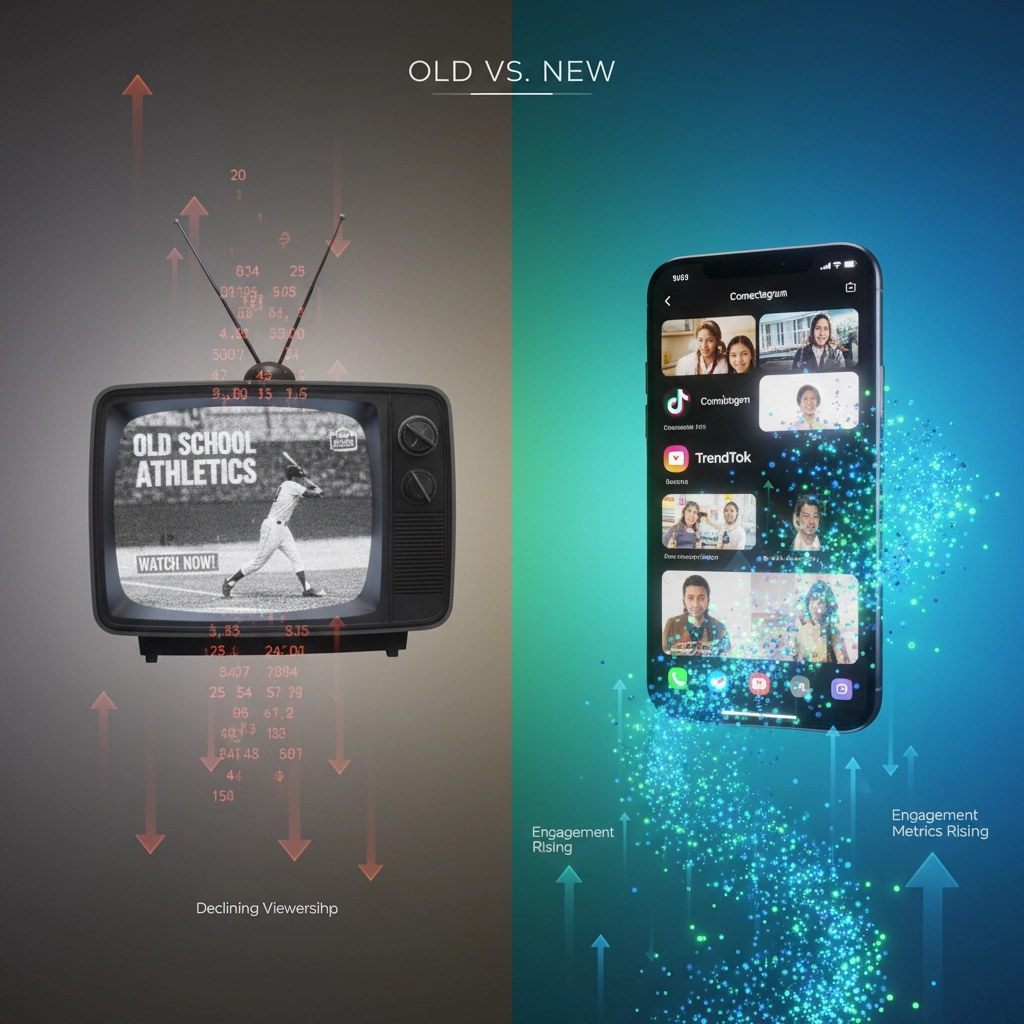Traditional sports advertising formats are experiencing measurable decline across multiple metrics in 2025. Television commercials, stadium billboards, and print advertisements no longer generate the return on investment that brands require. Data indicates that sports media advertising spend increased 14.7% year-over-year in Q1 2025, yet the distribution of these investments has shifted dramatically toward digital channels and experiential marketing approaches.
The Decline of Traditional Advertising Formats
Television Commercial Performance
Television advertising for sports content demonstrates clear downward trends. Sports betting television advertisements decreased 17% year-over-year in 2024 and dropped 44% since peak performance in 2021. Traditional broadcast viewership fell from approximately 70 million viewers to 50-55 million viewers, reducing the effective reach of television commercials.
Linear broadcast television maintains 84.1% of total sports media spending, yet streaming platforms deliver 66% better advertising results than traditional broadcast and cable channels. This performance gap indicates that traditional television advertising generates lower engagement rates and conversion metrics compared to digital alternatives.

Print and Static Media Limitations
Print advertising in sports publications and static billboard placements provide limited measurement capabilities and reduced audience engagement. These formats cannot offer personalization, real-time updates, or interactive elements that modern audiences expect. Print circulation numbers for sports magazines continue to decline as digital consumption increases.
Stadium billboard advertising faces similar constraints. Static displays cannot adapt to audience demographics or provide targeted messaging. The investment required for stadium advertising often exceeds the measurable return, particularly when compared to digital advertising options that offer detailed analytics and performance tracking.
Radio and Podcast Advertising Challenges
Traditional radio advertising during sports broadcasts reaches declining audiences as listeners migrate to streaming platforms and on-demand content. Radio advertisements cannot provide visual elements or interactive components that enhance brand messaging. The inability to target specific demographics or measure precise engagement metrics limits the effectiveness of radio advertising investments.
Digital Platforms and Channels Gaining Ground
Social Media Advertising Dominance
Social media platforms demonstrate superior engagement rates and targeting capabilities compared to traditional advertising channels. TikTok, Instagram, and Twitter provide sports brands with direct access to specific demographic segments and real-time engagement metrics. FC Barcelona utilizes 57+ million TikTok followers to share exclusive content that generates organic engagement without traditional advertising costs.
User-generated content on social platforms creates authentic brand interactions that traditional advertisements cannot replicate. Fans create and share content featuring brand products, generating advertising value without direct advertising spend. This organic promotion delivers higher trust levels and engagement rates than traditional commercial formats.

Streaming Platform Integration
Streaming services offer targeted advertising capabilities that traditional television cannot match. Advertisers can select specific content types, demographic profiles, and viewing behaviors to optimize advertisement delivery. Streaming platforms provide detailed analytics on advertisement performance, including completion rates, engagement metrics, and conversion tracking.
Interactive advertisements on streaming platforms allow viewers to engage with brand content directly through their devices. These advertisements can include product purchases, information requests, or social media connections that traditional television commercials cannot facilitate.
Influencer and Athlete Partnerships
Direct partnerships with individual athletes and sports influencers generate higher engagement rates than traditional celebrity endorsements. Athletes can create personalized content that resonates with their specific fan bases, delivering targeted messaging that traditional advertisements cannot achieve.
Micro-influencers within sports communities provide access to highly engaged niche audiences. These partnerships cost less than traditional advertising campaigns while delivering superior engagement metrics and conversion rates.
Emerging Advertising Technologies and Approaches
Augmented Reality and Virtual Reality Integration
Brands implement AR and VR technologies to create immersive advertising experiences that traditional media cannot provide. Heineken, PepsiCo, and Coca-Cola integrate AR activations into sports sponsorships, allowing fans to access exclusive behind-the-scenes content and interactive experiences.
VR advertising enables brands to place consumers directly into sports environments, creating emotional connections that traditional advertisements cannot establish. These technologies provide measurable engagement metrics and detailed user behavior data.

Personalization and Data-Driven Marketing
AI-powered personalization systems deliver customized advertising content based on individual user preferences, viewing habits, and engagement patterns. This approach generates higher conversion rates than traditional broadcast advertising that targets broad demographic segments.
Data analytics platforms provide real-time optimization capabilities for sports advertising campaigns. Brands can adjust messaging, targeting parameters, and content delivery based on performance metrics, improving campaign effectiveness throughout the advertising period.
Community-Building and Fan Engagement Strategies
Sports brands focus on building online communities rather than purchasing traditional advertising placements. These communities generate ongoing engagement and brand loyalty that extends beyond single advertisement exposures.
Discord, Reddit, and specialized sports platforms provide spaces for fans to engage with brand content organically. Brands that participate in these communities generate authentic interactions that traditional advertising cannot replicate.
Performance Metrics and Investment Shifts
Measurable Results Comparison
Streaming sports advertising delivers measurable performance improvements over traditional formats. Digital platforms provide detailed analytics including click-through rates, conversion tracking, and audience engagement metrics. Traditional advertising formats offer limited measurement capabilities and delayed performance feedback.
Cost-per-engagement metrics favor digital advertising approaches over traditional media investments. Brands can track specific user actions, purchase behaviors, and long-term customer value through digital channels, providing clear return on investment calculations.
Budget Allocation Changes
Sports advertising budgets increasingly allocate funds toward digital channels and experiential marketing approaches. While television maintains the largest spending percentage, the growth areas concentrate in streaming platforms, social media advertising, and interactive technologies.
Brands reduce traditional advertising spending to invest in content creation, influencer partnerships, and community engagement initiatives. These approaches generate sustainable audience relationships rather than temporary advertisement exposures.

Implementation Strategies for Modern Sports Advertising
Multi-Platform Content Distribution
Successful sports advertising campaigns utilize multiple digital platforms simultaneously to maximize reach and engagement. Content created for one platform can be adapted and distributed across various channels, increasing the return on content creation investments.
Cross-platform campaigns enable brands to guide audiences through comprehensive engagement journeys, from initial awareness on social media to detailed product information on branded websites and final purchase completion through e-commerce integration.
Real-Time Content and Event Marketing
Live sports events provide opportunities for real-time advertising that traditional pre-produced commercials cannot match. Brands can respond to game developments, trending topics, and fan conversations with relevant content that demonstrates timeliness and relevance.
Real-time marketing requires monitoring systems and rapid content creation capabilities. Brands that successfully implement real-time advertising generate higher engagement rates and social media sharing compared to static advertisement approaches.
The transformation of sports advertising in 2025 reflects fundamental changes in media consumption patterns and audience expectations. Traditional advertising formats continue to decline in effectiveness while digital platforms, experiential marketing, and community-building approaches demonstrate superior performance metrics and return on investment. Brands that adapt their advertising strategies to these emerging channels position themselves for continued success in the evolving sports marketing landscape.
Successful sports advertising in 2025 requires understanding where audiences consume content, how they prefer to engage with brands, and what technologies enable meaningful interactions. The data clearly indicates that traditional approaches no longer deliver the results that justify their costs, while digital alternatives provide measurable improvements in engagement, conversion, and long-term customer relationships.
